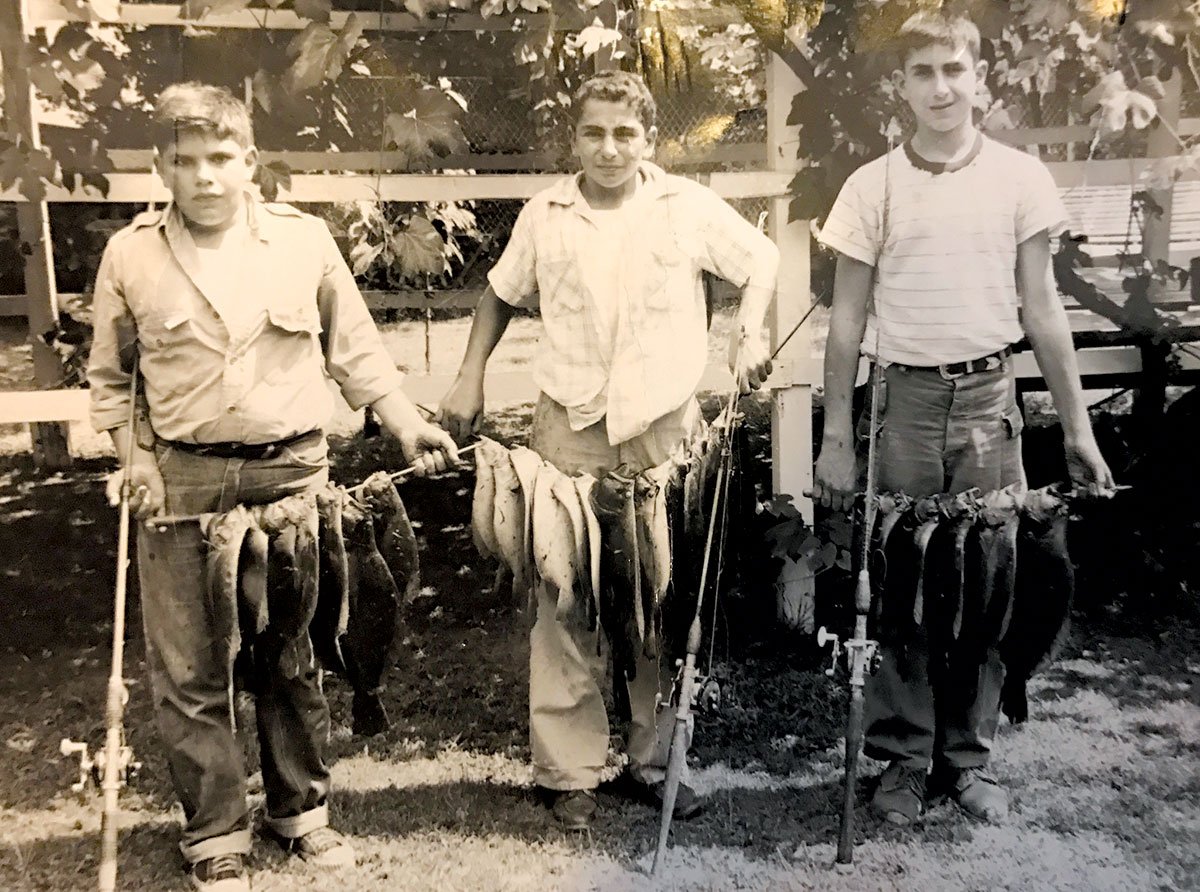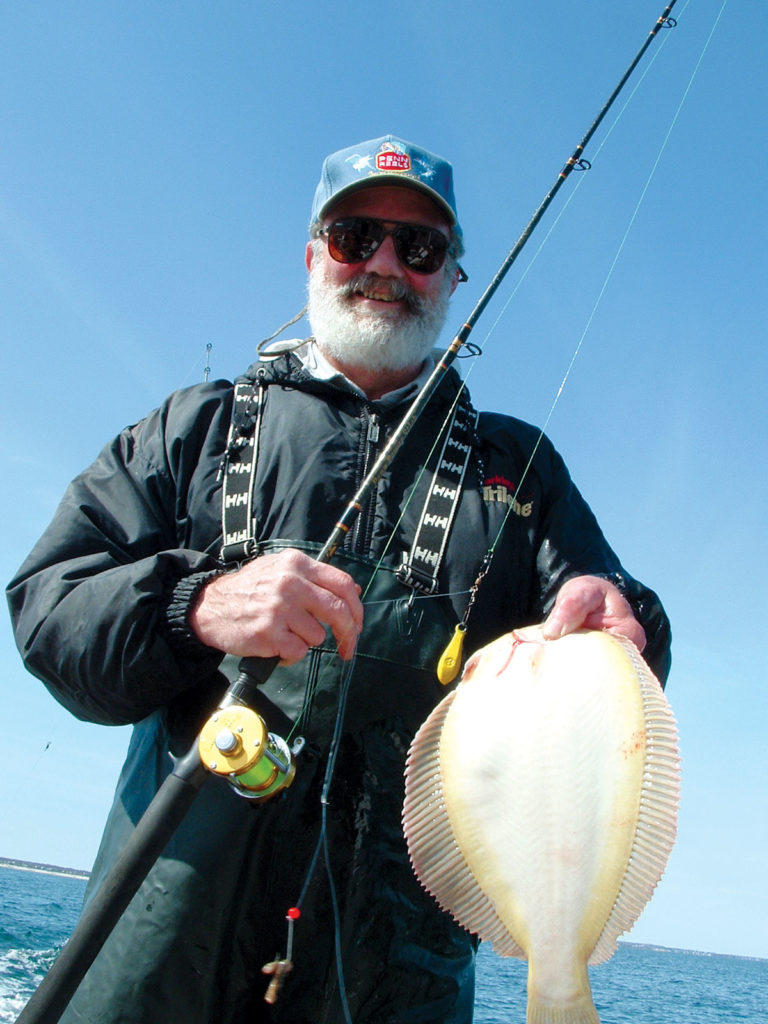
after a morning of drifting for summer flounder.
The long, sharp tines of the clam rake ripped another bite along the wall of the trench exposing the big seaworm in its burrow. That was only my second worm in 20 minutes of backbreaking digging along the south shore of the Taunton River.
That area of rocky shoreline had been worked over during the late fall and every winter day of extreme tides, so at this time of the season, it was very slim pickings. I knew that I should have crossed the bridge and walked a half mile to work a piece of the Somerset shoreline that most diggers were too lazy to hike to. I picked up my galvanized bucket and prepared to move out when a sharp whistle from the club porch caught my attention; it was the caretaker calling me in. My old mentor didn’t own a car, but he told me if I ran to the diner to get them coffee and Danish Steve would give me a ride to the Somerset towers on his way to Providence. The tide was still falling so I had time to spare, and my reward of a milk and jelly donut was welcome compensation.
After our hurried repast I put my rake and bucket in the trunk of Steve’s Plymouth and was dropped off at the water’s edge. “Don’t let those bastards from the ship yard sneak up on you. They think they own this stretch of beach so if you see them coming grab your bucket and get the hell out of here!” His advice was well taken as I was aware of them chasing—in some cases strong arming—the older diggers’ catches.
There are few situations as rewarding as digging along the edge of a nearly-pristine shoreline on the bottom of a new moon spring tide. The low spot I settled on was covered by gravel rather than the larger boulders higher up on the beach. No one had worked this bottom in more than a year, and my foot stomp on the surface prompted a few steamer (softshell) clams to spit and betray their location. I made my first probe about two feet from the water’s edge and the second deeper in the same place. Turning over the spoil I was rewarded with two dark-shelled steamer clams and a short, thick seaworm with active pincers that I put into the coffee can. I worked toward the edge of the water until the tide turned, chasing me back uphill as I tilled and filled my way to higher ground. I’d hit a bonanza of clams but it was the worms I was excited about. After almost two hours work I had a large coffee can with almost three-dozen worms packed into moist seaweed: my ticket to a day of flounder fishing with the caretaker.
The precious worms were rolled in old newspaper to dry them out (too much moisture or freshwater will kill them), and then stored in a wooden box with semi-moist seaweed. They were covered and placed in a cool location, out of the sun, on the upstairs porch in the cold pre-spring temperatures. We had the use of the Tavares brother’s skiff with the 15-horsepower Scott Atwater outboard engine, which we had fitted out for our early-season forays.
On a cold Saturday morning, we bounced our way up Mt Hope Bay, through the Tiverton Basin and into the lower Sakonnet River with the two of us wet and cold by the time we turned into the narrow channel to Nanaquaket Salt Pond. In anticipation of skim ice my mentor tied an old manila tugboat bumper on the bow and tossed it overboard before we hit the ice. We motored slowly into the ice, loudly crunching and splitting a channel that closed in behind us as we headed to the edge of the mud flat where the flatties were known to winter.
From mid- to late December until mid-March the winter flounder are in a lethargic state just short of hibernation, yet despite the doldrums they manage to complete their spawning rituals from mid-February to March depending on the temperatures. We checked our ranges using the tall brick chimney on a hillside house with the big pine at the water’s edge. Using his sounding lead we moved out until we approached the edge of the deep hole in the middle of the pond. Once lined up I dropped the lead weight that secured the cork float to provide a marker for our next move, which was dragging the Danforth backwards to stir up the bottom and loosen the tiny worms and marine life buried in rich, thick mud. That was the dinner bell for the flatties as an abundance of food was dredged up into the water column.
Four passes around our marker and I set the anchor to allow us to lay right over our dredge spoil. With short pieces of fresh seaworm covering a pair of the caretaker’s long Chesterton flounder hooks above a 2-ounce sinker, we were in business. The night before I visited a mussel bed at low tide and scraped up a 5-gallon galvanized pail of them to use as chum. I baited my hand line, tied it off the stern post and began crushing mussels with a 5-pound lead sash weight. The caretaker had brought along large red onion bag weighted with a heavy round boulder into which the chum went. Using heavy parachute cord, he dropped the bag off the bow tying it short so the movement of the hull would cause it to bounce on the bottom and release particles of our chum.

As soon as I removed the two turns securing my hand line I felt life at the end; however, my detection didn’t go unnoticed. “Looks like the boat is a better fisherman than you,” he chuckled. Nothing on board ever escaped the old man, but he gave me a broad smile when a thin 14-inch flattie came over the rail. “You didn’t catch that fish, it choked itself to death.” It looked like another trip when I was in for a good-natured ribbing, but as long as he was smiling I enjoyed every minute of it.
The old timer fished a hand line and a heavy bamboo rod with an Ocean City reel spooled with 9-thread linen line; an outfit which he referred to as the “winch.” With no size, bag or seasonal limits in place we could keep as many fish of any size as we desired, but the Caretaker set his own standards and I believe it was because he said there wasn’t enough meat on anything smaller than 14 inches to make it worth putting a blade to. We picked away at five thin-but-beautiful flatties from 10 to 15 inches until they went back to sleep again. “Time go get back to work again kid,” which was my order to haul the anchor and make another few passes to stir up the bottom again. Three more turns and we were back on the anchor with a bag of fresh chum deployed off the bow.
The bites came faster this time as the logy flats found the juicy worms to their liking. One of those fish was a handsome 16-inch yellow tail I hooked into but as I was proudly displaying the fish the old man noticed a swollen roe sack and said it had to go back. “We’ve got to put those mamas back, boy, so they can re-populate the species. Think of what it would be like to lose this healthy fishery because we were too greedy.” My mentor was way ahead of his time.
I wonder what he’d think if he came back to find there were regulations enacted that closed off every piece of bottom from which he had ever harvested his flounder? Today all of Mt Hope Bay, its tributaries and all of Narragansett Bay is closed to winter flounder fishing. If I need to scratch my winter flounder itch I can travel to Boston and Quincy Harbor or Cape Cod Bay where I have enjoyed some great trips with friends who also relish revisiting their boyhood days when the lowly winter flounder was the number one food and sportfish in our area.
About 40 years ago, Tim Coleman talked me into trailering my rig to Quincy for a flounder story for our expanding New England Fisherman Magazine. We launched off a crater-pocked ramp in Hough’s Neck, and even though we had never fished there before we filled a 50-quart cooler with big flounder and a few legal cod. I stopped fishing halfway into the trip and began filleting. Everyone I knew had fresh flounder for dinner all that week, and as usual Coleman never took a single fillet home.
This spring I will be making at least one trip to Quincy Bay with a Rhode Island friend who wants to end a 35-year flounder drought; then make another trip to Wellfleet to fish with my friend and Blackbeard’s B&T owner Paul Newmier and his Jac’s Mate crew. With New Jersey, New York, Connecticut and Rhode Island having a two-fish bag limit of flounder over 12 inches, I guess we aren’t that bad off in comparison. Make certain to check your state regulations for closed seasons and restricted areas. Good Glory, what I would give to be able to take my sons and grandchildren flounder fishing on my old home grounds.



